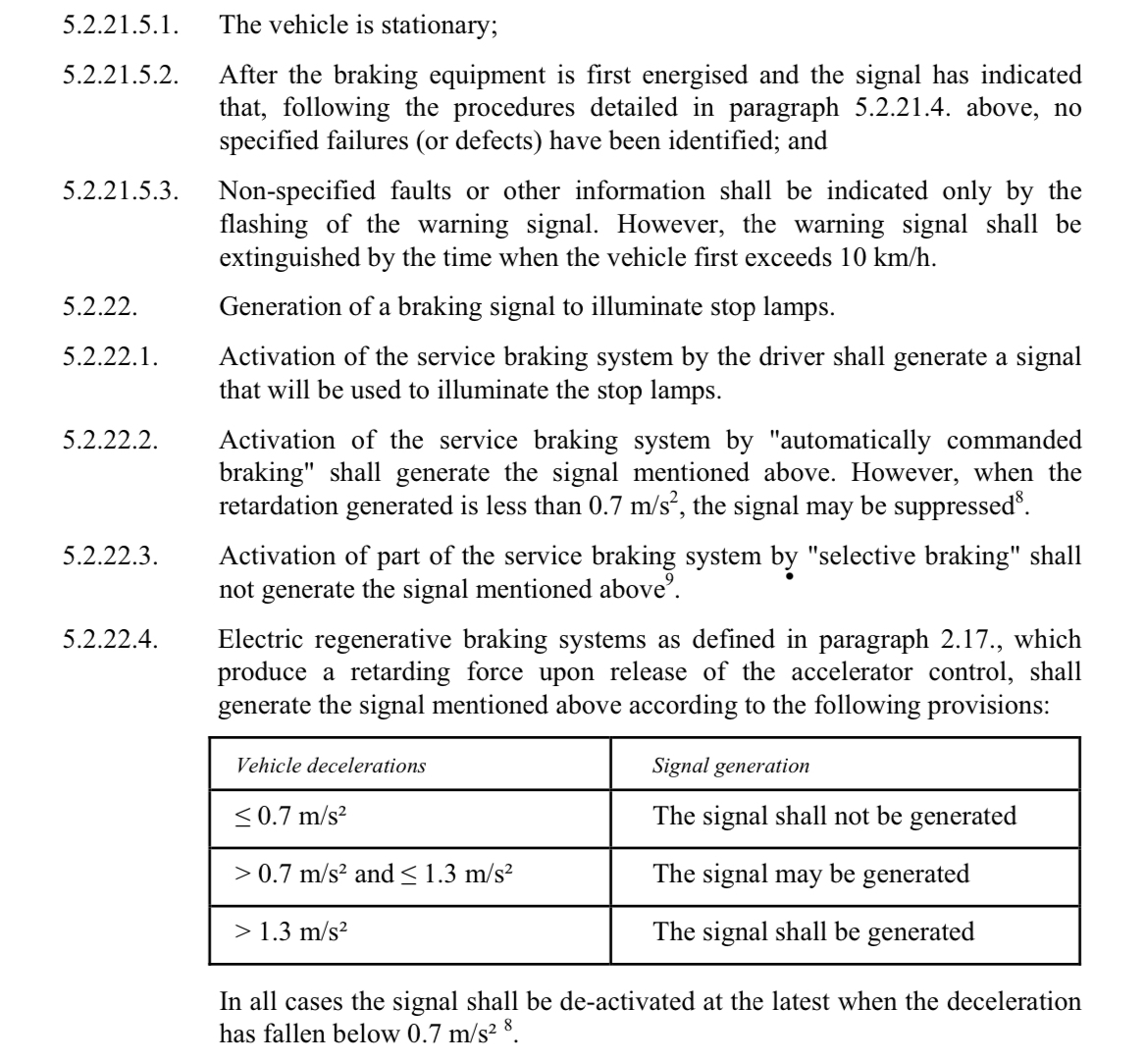Standardised is a funny word, a car manufacturer doesn’t standardise. Laws and 3rd parties like ANCAP do.
When they need to do it to sell it with certain safety requirements, they will.
However, even if those happen, and car makers today start building them with that, it’ll take a decade or longer before you’ll start seeing them in majority on the road. So even if you lobby for it, expect time since I’d say less than half of all people buy new cars, so it’s not until the second hand market sees it will it be commonplace.
Right now the second hand market is starting to see things like collision avoidance systems and they will often flash brake lights when emergency braking on behalf of the driver.
Have you ever been behind a car with a driver that has one foot on the brakes and the other on the gas. It seems to resemble the effect you are looking for and incredibly distracting and annoying. When brake lights go on you expect them to be making a stop or rapid deceleration so you do the same as well as the people behind you and all of the sudden you are speeding up, slowing down, back and forth. It’s becomes a terrible way to drive. The reason we have 2 eyes is to be able to judge these things and it works fine if you aren’t driving distracted.
Some EVs and hybrids have a ‘one foot driving’ mode where if you take your foot off the gas, it does start to actively brake and you will eventually come to a complete stop. Technology Connections did a video on it a little while back, showing how it can be bad if the brake lights aren’t programmed to come on in this situation.
Most have KERS. This is what it is. My brake lights go on when it hits a certain % of KERS full effect.
What if you don’t have 2 eyes?
Ok i’ll bite. Because why? How can you decelrate quickly enough to need to notify the driver behind you without braking?
Engine or regenerative braking can very quickly slow down a vehicle but may not activate the brake lights depending on the manufacturer.
Or crashing, I guess.
EVs have regenerative braking, where when you let off the accelerator, it immediately starts slowing down, quickly. But the brake lights don’t come on. This would make driving behind EVs safer.
Perhaps when EVs use regenerative braking, they should display their brake lights. Use brakes, show brake lights, same rule as before just enforce it.
Perhaps when EVs use regenerative braking, they should display their brake lights. Use brakes, show brake lights, same rule as before just enforce it.
Agreed.
I would like to share this with you: https://youtu.be/U0YW7x9U5TQ
Old auto trannys didn’t have a bypass. You dropped to first some obeyed
Other than regen braking like everyone said (which really slows down a car almost effectively as brakes when set to the highest regen setting; look up “one pedal driving”), you can also slow down a car quite rapidly in a manual transmission if you skip a gear or two when downshifting. No brake lights come on when you do this, and honestly I think that they should.
Because your life isn’t worth the extra dollar to them.
More accurately, if they added one single extra component like that, they would raise the MSRP by like $500. Because we live in capitalist hell. Therefore, it’s included in higher quality cars, and/or as an optional feature. Like most safety anything, they won’t automatically include it in anything unless they are literally forced to by law. And even then though sometimes not and say they did. And still up charge you for it. Isn’t capitalism fan-fucking-tastic?
They take the worst of the three options. They don’t eat the dollar, they don’t put it in the base model for 500 dollars extra, they lock it behind the big wheels, sporty engine, and wood trim so only the rich people have safety features that aren’t absolutely required by law.
A related tangent is now that there are so many distracted drivers, engine braking in a standard can become hazardous. I often will tap my foot on the brake so the people behind will register that my speed is decreasing.
I beleive that should be common practice when down shifting to slow because it’s not much different from braking without any brake lights. However, I’ve come to also trigger the lights even when coasting down in top gear. The slightly harder engine braking in a manual, even in top gear, combined with the increase of distractions, has me concerned about the same thing as you.
I heal-toe, so I’m pressing the brake as I’m engine braking. But I think I’ve read somewhere that newer manuals actually will turn on the brake light on heavy deceleration via engine brakes, I just don’t know firsthand because every very I’ve owned has been old as shit. Ditto with electric cars that have aggressive regen braking.
Declaration can happen through a variety of means. Simply not accelerating would be the first one, due to friction. But even steadily accelerating on an upward slope would decrease the vehicle’s speed, and you don’t want to give vehicles behind the idea that a stop is being initiated.
You’ve spelled out the entire problem but have come to incorrect conclusions. If you’re directly behind a car, it becomes hard to sense acceleration or deceleration of other vehicles. More importantly, the brake is often used to decelerate on highways and not initiate a stop. This all leads to a lot of confusion and ultimately crashes every year.
The situations you mentioned are exactly the problem areas. Not accelerating it slowing down, often quite quickly, to make an exit. Dangerous. Going up a slope may or may not change speed, which needs to be known. Again dangerous. Same with downhill which is actually more dangerous not knowing how hard braking is happening.
So we have the technology to fix this. We can invent either variable break lights that change brightness or zoned lights that tell you “I’m slowing down” versus “I’m braking hard”. We could fix this because cars are dangerous enough as is
I’ve driven rentals that put the brake lights on if you did not have a foot on the gas, and only lit a 3rd brake light when actually pressing the brake. Dunno why it isn’t more common tho.
Because a think called a “brake light” should light go only to indicate braking?
Reminds me of the cars that now have the reverse lights on when they’re just in park making me think they’re going to back up but never do.
This is probably country/region specific but my car (Tesla) illuminates the brake lights when it detects a certain level of deceleration. Also my work vehicles (Volvo V90 CrossCountry and XC60) do this. Finland/Sweden in my case. My car also flash the hazards when it detects hard braking and I’ve seen quite many euro cars do this. I agree that this should be standard.
I feel like there must be a Technology Connections video about this.
Gosh that guy sure is good at talking about various types of indicator lights.
Because the brake light indicates braking, and is connected to the brake? This is already a perfect solution.
An accelerometer is a terrible idea to replace this. You would have to cover the car with sensors and tune them so that accelerating uphill doesn’t trigger the brake light, and that braking downhill will successfully trigger the brake light.
One foot EV driving does turn on the brake lights when it exceeds a certain deceleration amount.
But most EVs default to slowly charging the car and slowing it in a similar way to ICE compression braking (which uses 0 fuel in fuel injected cars BTW).
Anyway regardless of how the vehicle is slowing down, the NHTSA allows for the brake lights to be activated by other devices that slow the car (not just the pedal), and the UN requires brake lights be applied if the vehicle deceleration exceeds
https://unece.org/fileadmin/DAM/trans/main/wp29/wp29regs/R13hr2e.pdf

That is not the case in the US or in the EU. Things like GM and Hyundai won’t even show the brakes with the foot completely off on full regen. You will specifically say you cannot do have a secondary braking systems as well which is where I think the issue comes in. BMW and Mercedes both only show brake lights when you fully remove your foot from the accelerator with regen turned on
These are the rules both in EU and US and have been for quite a while, and both BMW and MB implement them.
$
Technology Connections on YT has. Awhile rant about this. https://youtu.be/U0YW7x9U5TQ?si=SZaEzNCDKoLXhx83
A rant? Alec? Surely, you jest.
That’s a fairly complicated system to replace what is just an ultra simple switch at the pedal. The latter is even pretty likely to last the life of the car.
The problem is with electric cars that can be driven with one pedal most of the time
I was thinking about this last time I drove an ev (ioniq 5). It will really decelerate quite hard when you lift off, and it’s configurable by the driver.
I don’t think they need to do it with an accelerometer, but if the regeneration system is applying more braking force than it would take to turn on the light with the brake pedal, it should turn the light on.
Either that or they should require the brake pedal to be used beyond that point.
Edit: actually it just occurred to me that it might be no worse than downshifting in a normal car. Maybe it’s not a big deal.
Most EVs do put on the brake lights when you lift off the pedal and the regen system kicks in.
An accelerometer isn’t a good idea; but if the car’s systems are responding to a command from the driver to slow down, be that a press of the brake pedal, lifting off the accelerator in a car designed for 1-foot driving, etc. it should illuminate the stop lamps.
The i5 does turn on the brake lights when you use regen modes. They did have a firmware update to make the logic a bit better earlier this year though.
Because there are laws that specify when the brake light has to come on, and it isn’t when the car shows down (slightly). You could be starting to go up hill, or a list of other reasons. The point of brake lights isn’t too signify the car slowing, but that the driver intends to slow down. Which is also why it doesn’t come on if you’re motor breaking" (is that the right term?).
This obviously varies wildly depending on where you are in the world. I’m also sure there are some places where it would be allowed.
Because there are laws that specify when the brake light has to come on, and it isn’t when the car shows down (slightly).
To be clear, the laws say when it must illuminate. They do not (in the US) prevent illuminating it for other reasons in any way. The law says the light must illuminate/burn if you are actively pressing the brake pedal, but does not prevent it from also illuminating if a certain amount of regenerative braking is applied or a deceleration is detected. Theoretically an automaker could get away with making the brake lights simply always illuminate (and that loophole would be fixed in days, so no one does it).
That is indeed US-specific. I’m in the EU, and here it’s defined by when and how it’s switched. Specifically, it is required to be tied to the brake pedal (i.e. then intention to brake) and/or the hand brake being pulled. It is not allowed to illuminate otherwise. But the exact specifics probably also vary by country here. That’s why I emphasized that part.
EDIT: There are actually deceleration values in some laws, possibly tied to regulation of EVs and the regenerative braking. Since that isn’t necessarily tied to the brake pedal when silmulating engine braking, but can be adjusted in strength at will (it isn’t tied to the mechanics of the drag of an idling engine as it would with an ICE). A quick google told me that the lights are allowed to come on at 0.7 m/s² and are required to come on at 1.3 m/s². This obviously implies that they are NOT allowed to come on below 0.7 m/s². This still applies only to (pure) EVs, as far as I can tell (not hybrids, and not ICE powered cars).
Yep, EU as usual having reasonable and well-thought out laws, give the US about 5 more years and they’ll make it law here too.














